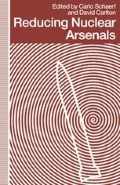Abstract
The Intermediate-range Nuclear Forces (INF) Treaty, signed on 8 December 1987, has opened the prospect for substantial reductions in the nuclear arsenals of the superpowers, and, perhaps, of the other nuclear powers as well, all the way down to a ‘minimum deterrent’ (of the order, say, of one per cent of the present strategic arsenals) or even, eventually, to zero. This process will certainly require many years, perhaps decades, and it will of course be essential that throughout a situation of strategic stability is preserved. The implementation of this process is a challenging task for decision-makers and for relevant diplomatic and governmental machineries, including advisers drawn from the technological and scientific community.
Access this chapter
Tax calculation will be finalised at checkout
Purchases are for personal use only
Preview
Unable to display preview. Download preview PDF.
Notes
Theodore B. Taylor, ‘Verification of Elimination of Nuclear Warheads’, Science and Global Security, vol. 1, no. 1–2 (1989);
and E. Amaldi, U. Farinelli and C. Silvi, ‘On the Utilization for Civilian Purposes of the Weapon Grade Nuclear Material that may become available as a Consequence of Nuclear Disarmament’, paper presented to the Workshop on International Security and Disarmament: the Role of the Scientific Academies (Rome, June 1988).
Frank von Hippel, ‘Draft Summary of the Results of an Independent Foundation for the Survival and Development of Humanity sponsored Workshop on Cooperative Arrangements for the Management and Disposal of Nuclear-Weapon-Usable Materials’, Princeton, 28 July 1988.
Taylor, ‘Verification of Elimination of Nuclear Warheads’; Amaldi, Farinelli and Silvi, ‘On the Utilization for Civilian Purposes of the Weapon Grade Nuclear Material’; and Federation of American Scientists Public Interest Report, March 1988, pp. 4–5.
Amaldi, Farinelli and Silvi, ‘On the Utilization for Civilian Purposes of the Weapon Grade Material’; and T. B. Cochran, W. M. Arkin, R. S. Norris and M. M. Hoenig, Nuclear Weapons Data Book: Volume II: U.S. Nuclear Warhead Production (Cambridge, Mass., 1987).
David Albright, ‘Civilian Inventories of Plutonium and Highly Enriched Uranium’, in Paul Leventhal and Yonah Alexander (eds) Preventing Nuclear Terrorism (Lexington, Maryland, 1987) pp. 265–97.
J. Taylor, K. Stahlkopf, C. Braun, R. Belant, J. Barton and T. Shea, ‘Converting Nuclear Weapons to Peaceful Use’, unpublished Electric Power Research Institute (EPRI) Report, July 1983.
A summary of the main points in this report is in J. Taylor, R. Balent, J. Barton and T. Shea, ‘Converting Nuclear Weapons to Peaceful Use’, Bulletin of the Atomic Scientists, February 1985.
Editor information
Editors and Affiliations
Copyright information
© 1991 Unione Scienziati per il Disarmo Convegno Internatzionale
About this chapter
Cite this chapter
Amaldi, E. (1991). The Future Use of Redundant Weapon-grade Material. In: Schaerf, C., Carlton, D. (eds) Reducing Nuclear Arsenals. Palgrave Macmillan, London. https://doi.org/10.1007/978-1-349-12180-9_6
Download citation
DOI: https://doi.org/10.1007/978-1-349-12180-9_6
Publisher Name: Palgrave Macmillan, London
Print ISBN: 978-1-349-12182-3
Online ISBN: 978-1-349-12180-9
eBook Packages: Earth and Environmental ScienceEarth and Environmental Science (R0)

